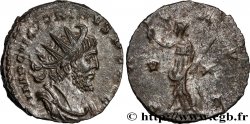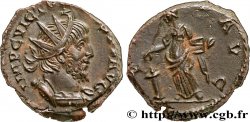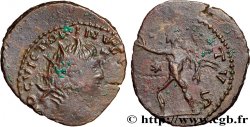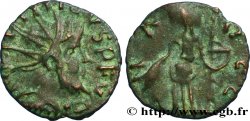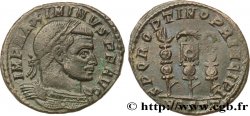brm_143530 - VICTORINUS Antoninien
Nicht verfügbar.
Artikel auf unserem Online-Shop verkauft (2011)
Preis : 10.00 €
Artikel auf unserem Online-Shop verkauft (2011)
Preis : 10.00 €
Type : Antoninien
Datum: c. début 271
Name der Münzstätte / Stadt : Trèves
Metall : Scheidemünze
Der Feingehalt beträgt : 20 ‰
Durchmesser : 20 mm
Stempelstellung : 6 h.
Gewicht : 2,81 g.
Seltenheitsgrad : R1
Kommentare zum Erhaltungszustand:
Usure importante. Patine marron-gris
N° im Nachschlagewerk :
Vorderseite
Titulatur der Vorderseite IMP C VICTORINVS P F AVG.
Beschreibung Vorderseite Buste radié, drapé et cuirassé de Victorin à droite, vu de trois quarts en avant (A).
Übersetzung der Vorderseite “Imperator Cæsar Victorinus Pius Felix Augustus”, (L’empereur césar Victorin pieux heureux auguste).
Rückseite
Titulatur der Rückseite VICT-ORIA AVG.
Beschreibung Rückseite Victoria (la Victoire) courant à gauche, tenant une couronne de la main droite et une palme de la gauche.
Übersetzung der Rückseite "Victoria Augusti", (La Victoire de l'auguste).
Kommentare
Ce type, frappé à Trèves avec le buste drapé, pose un gros problème de classement avec le Schulzki. En effet, la planche accompagnant le numéro 22a (seul type avec Victoria pour Trèves) n’est pas celui décrit dans le texte... Cependant, c’est bien le plus courant des deux types, qui reste tout de même rare. L’autre type semble rarissime malgré le classement en C2 dans le même ouvrage.
This type, struck in Trier with the draped bust, poses a major classification problem with the Schulzki. Indeed, the plate accompanying number 22a (the only type with Victoria for Trier) is not the one described in the text... However, it is indeed the most common of the two types, which remains nonetheless rare. The other type seems extremely rare despite the classification in C2 in the same work
This type, struck in Trier with the draped bust, poses a major classification problem with the Schulzki. Indeed, the plate accompanying number 22a (the only type with Victoria for Trier) is not the one described in the text... However, it is indeed the most common of the two types, which remains nonetheless rare. The other type seems extremely rare despite the classification in C2 in the same work








 Berichten über einen Fehler
Berichten über einen Fehler Die Seite drucken
Die Seite drucken Teilen meiner Auswahl
Teilen meiner Auswahl Stellen Sie eine Frage
Stellen Sie eine Frage Einlieferung/Verkauf
Einlieferung/Verkauf
 Details
Details